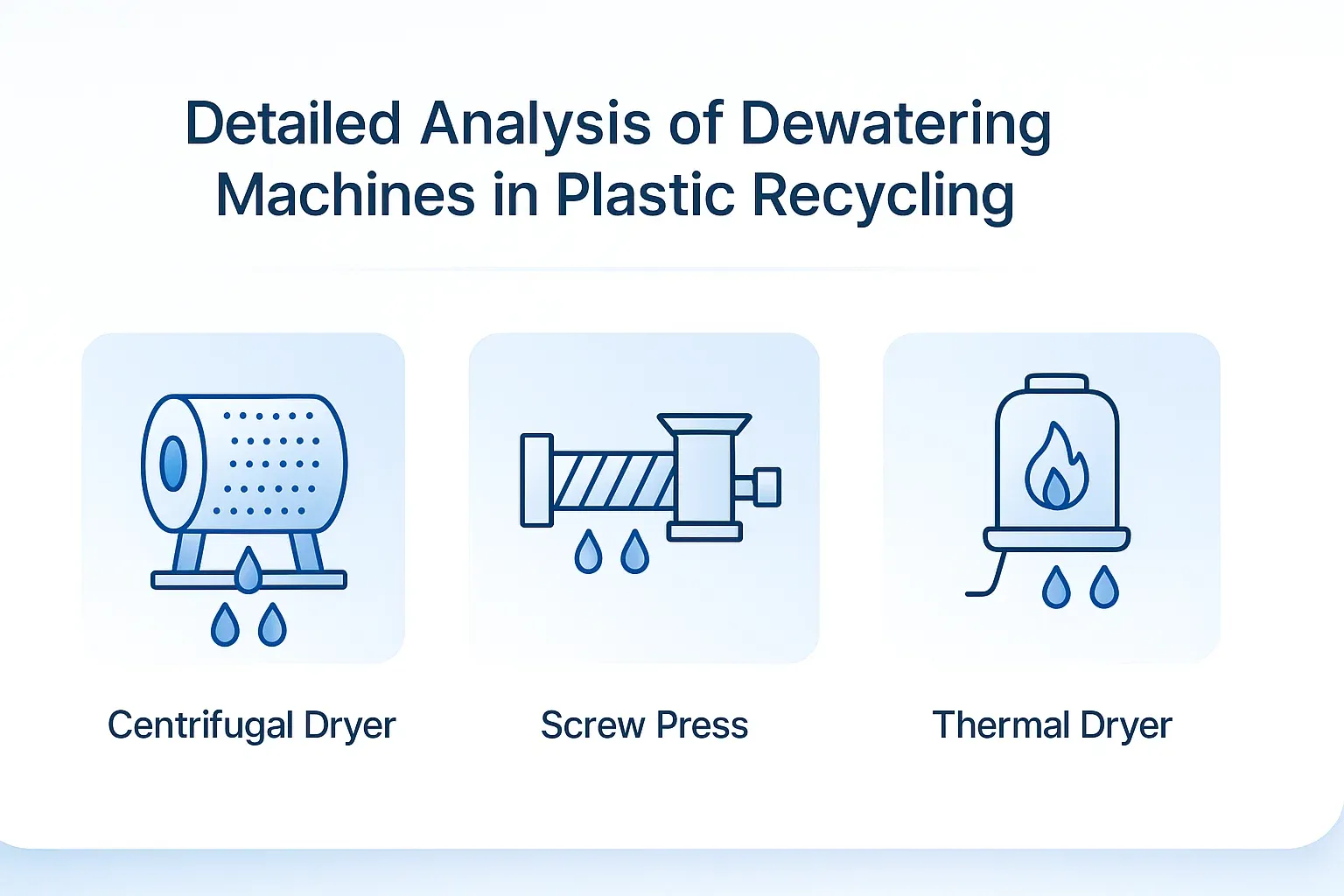Recikliranje plastike predstavlja temelj suvremenih inicijativa za održivost, s ključnim ciljem minimiziranja otpada i domišljate prenamjene materijala u nove, vrijedne proizvode. Unutar složenih faza procesa recikliranja, odvodnjavanje pojavljuje se kao apsolutno ključni korak. Njegova primarna funkcija je učinkovito uklanjanje vode iz oprane plastike, pažljivo je pripremajući za naknadnu, transformativnu obradu.
Ovaj članak nudi detaljno istraživanje neizostavnih uloga, različite vrste i značajne prednosti strojeva za odvodnjavanje u području recikliranja plastike. Cilj nam je pružiti vrijedne uvide stručnjacima iz industrije koji žele optimizirati svoje poslovanje i ekološki osviještenim čitateljima koji žele razumjeti mehanizme učinkovitog recikliranja.
Razumijevanje strojeva za odvodnjavanje: Neopjevani heroji recikliranja plastike
Strojevi za odvodnjavanje su sofisticirani, specijalizirani dijelovi opreme pažljivo konstruirani za izdvajanje vode iz različitih materijala. U specifičnom kontekstu recikliranja plastike, njihova glavna funkcija je uklanjanje viška vlage iz plastike koja je prošla temeljitu fazu pranja. To osigurava da su plastike optimalno spreman za ključne naknadne procese kao što su sušenje, peletiranje ili ekstruzijaZašto je ovo toliko važno? Višak vode može ozbiljno ugroziti ukupnu učinkovitost linije za recikliranje, potencijalno oprema osjetljiva na oštećenja dalje u budućnosti, i kritično, negativno utjecati na kvalitetu i integritet konačnog proizvoda od reciklirane plastike.
Tipičan, dobro strukturiran proces recikliranja plastike općenito obuhvaća sljedeće ključne faze:
1. Prikupljanje i sortiranje – Ova početna faza uključuje prikupljanje plastičnog otpada, a zatim pažljivo odvajanje prema vrsti (npr. PET, HDPE, LDPE) i kvaliteti, budući da različite plastike zahtijevaju različitu obradu.
2. Pranje – Sortirana plastika se zatim temeljito pere kako bi se uklonili onečišćujući materijali poput prljavštine, ostataka hrane, etiketa, ljepila i drugih nečistoća.
3. Odvodnjavanje – Pranje nakon pranja, tu leži naš fokus. Strojevi za odvodnjavanje rade na tome da mehanički izvuku što više vode iz očišćenog plastičnog materijala.
4. Sušenje – Čak i nakon odvodnjavanja može ostati određena količina vlage. Naknadna faza sušenja dodatno smanjuje taj sadržaj vlage kako bi se zadovoljili strogi zahtjevi obrade.
5. Peletiranje/ekstruzija – Konačno, čista, suha plastika se topi i pretvara u pelete (za kasniju upotrebu) ili izravno ekstrudira u nove proizvode, čime se završava ciklus recikliranja.
Istraživanja u industriji dosljedno ističu značajna varijabilnost u sadržaju vlage nalazi se u opranoj plastici. Na primjer, materijali poput plastičnih folija mogu zadržati do 30% voda po težini, dok druge vrste krutih plastika mogu držati čak 70% vlažnost prije koraka odvodnjavanjaPrimarni cilj procesa odvodnjavanja je drastično smanjiti ovu razinu vlage na prihvatljiviji raspon, obično između 5% i 30%, ovisno o specifičnoj vrsti stroja za odvodnjavanje i prirodi plastike. To osigurava optimalne uvjete za sljedeće faze sušenja i obrade.
Vrste strojeva za odvodnjavanje i njihovi mehanizmi
Industrija recikliranja plastike koristi nekoliko različitih tehnologija odvodnjavanja, od kojih svaka nudi jedinstvene prednosti prilagođene specifičnim vrstama plastike, zahtjevima protoka i operativnim potrebama.
1. Centrifugalni strojevi za odvodnjavanje
Centrifugalni strojevi za odvodnjavanje, poznati i kao centrifugalni sušači, iskorištavaju snagu velike brzine sile predenja za učinkovito uklanjanje vode iz plastike. Dok se mokri plastični materijal ubacuje u brzo rotirajući bubanj ili košaru, centrifugalna sila gura vodu prema van kroz perforirano sito, dok se dehidrirane plastične krutine zadržavaju. Posebno su učinkoviti za obradu male plastične pahuljice, mljeveni materijal i čestice, i često se nalaze u postrojenja za recikliranje plastičnih folija i operacije rukovanja krutim plastičnim pahuljicama.
• Ključne prednosti: Visoka operativna učinkovitost, brzo smanjenje vlage, relativno kompaktan otisak.
• Sadržaj vlage nakon odvodnjavanja: Obično postiže 5-30% preostala vlaga, ovisno o materijalu i postavkama stroja.
• Upotreba: Vrlo pogodno za različite vrste plastike, uključujući PET, HDPE, LDPE i PP pahuljice i filmovi.
2. Stupnjevi sušači
Stepenaste sušilice predstavljaju specijaliziraniji pristup koji koristi višestupanjski mehanički proces odvodnjavanjaObično imaju jedinstven stepenasto oblikovano sito za košaru i posebno dizajniran rotor koji nježno prevrće i prenosi materijal kroz različite zone. Ovo progresivno djelovanje postupno izvlači vodu. Posebno su učinkoviti u recikliranju inženjerske termoplastike poput polikarbonata (PC) i polipropilena (PP) gdje su iznimno niske konačne razine vlage ključne za održavanje integriteta materijala.
• Ključne prednosti: Sposoban za postizanje ultra niske razine preostale vlage (npr. 0,4% do impresivnih 0,06 wt%), što osigurava iznimno visokokvalitetni reciklirani materijal.
• Sadržaj vlage nakon odvodnjavanja: Može biti nisko kao 0.06%, što značajno smanjuje potrebu za termičkim sušenjem.
• Upotreba: Idealno za visokokvalitetni reciklažni procesi koji zahtijevaju vrhunsku kvalitetu proizvodnje, posebno za plastiku osjetljivu na hidrolizu.
3. Strojevi za stiskanje (vijčane preše)
Strojevi za cijeđenje, često koristeći mehanizam vijčane preše, uklanjaju vodu primjenom kontinuiranog mehanički pritisakVlažni plastični materijal se dovodi u komoru gdje ga rotirajući vijak prenosi i pritišće uz perforirano sito ili ograničeni izlaz. Taj tlak učinkovito istiskuje vodu. Vrlo su robusni i idealni za velika postrojenja za recikliranje plastike s velikim količinama. Posebno su učinkoviti za odvodnjavanje fleksibilni materijali poput plastičnih folija i meke plastike, često smanjujući vlagu na čak do 3% u nekim naprednim primjenama.
• Ključne prednosti: Općenito energetski učinkovito u usporedbi s termičkim sušenjem, sposobno za obradu velikih kontinuiranih volumena, učinkovito za materijale koje je teško odvoditi.
• Sadržaj vlage nakon odvodnjavanja: Tipično 2-10%, uvelike ovisi o specifičnom modelu, svojstvima materijala i operativnim parametrima.
• Upotreba: Iznimno učinkovito za plastične folije (LDPE, LLDPE), poljoprivredne folije, tkane vreće i ostale mekane plastike.
Svaka vrsta stroja za odvodnjavanje predstavlja izrazite prednostiOptimalni izbor ovisi o pažljivoj procjeni čimbenika kao što su početni i ciljni sadržaj vlage, specifična vrsta plastike koja se obrađuje te ukupni kapacitet i ekonomski ciljevi postrojenja za recikliranje.
Ključne prednosti strojeva za odvodnjavanje u recikliranju plastike
Integracija učinkovitih strojeva za odvodnjavanje u operacije recikliranja plastike donosi mnoštvo značajnih prednosti, optimizirajući cijeli proces:
1. Smanjenje težine i volumena materijala
Učinkovitim uklanjanjem većine viška vode, strojevi za odvodnjavanje značajno smanjiti i težinu i volumen prerađenog plastičnog otpada. Ovo smanjenje ima izravan pozitivan utjecaj na logistiku, znatno olakšavajući skladištenje i prijevoz upravljivije i isplativije.
Primjer izračuna:
• Razmotrite 1 tona (1000 kg) suhog plastičnog otpada što u početku vrijedi Sadržaj vlage 70%Ukupna težina ovog mokrog materijala zapravo je 1000 / (1 – 0,70) = ~3.333 kg (3,33 tone).
• Nakon učinkovitog odvodnjavanja smanjuje sadržaj vlage na 20%, ukupna težina postaje 1000 / (1 – 0,20) = 1.250 kg (1,25 tona).
• To predstavlja značajan ~62,5% smanjenje ukupne težine, što dovodi do značajno niži logistički troškovi (gorivo, rukovanje, kapacitet vozila) i povećana učinkovitost obrade po seriji.
2. Optimalna priprema plastike za daljnju obradu
Za sljedeće faze kao što su ekstruzija i peletiranje Da bi bio učinkovit i dao visokokvalitetne rezultate, sadržaj vlage u plastičnoj sirovini mora biti minimalan. Višak vode može uzrokovati niz problema, uključujući materijalni nedostaci kao što su šupljine, srebrne pruge ili krhkost u konačnom proizvodu. U težim slučajevima može čak dovesti do eksplozija pare unutar strojeva za obradu, uzrokujući oštećenje skupe opreme poput ekstrudera. Odvodnjavanje osigurava da je plastika optimalno pripremljen, minimizirajući te rizike.
3. Poboljšanje kvalitete reciklirane plastike
Reciklirana plastika više kvalitete izravna je posljedica učinkovito odvodnjavanjeMinimiziranjem preostale vlage, prerađivači mogu spriječiti uobičajene probleme kao što su pukotine nakon oblikovanja, savijanje ili oslabljeni strukturni integritet u konačnim proizvodima. Ova poboljšana kvaliteta posebno je važna za industrije u kojima precizne specifikacije materijala i standardi performansi nisu predmet pregovora, što omogućuje recikliranoj plastici da učinkovitije konkurira djevičanskim materijalima.
4. Postizanje značajnih ušteda troškova i povećanje ukupne učinkovitosti
Značajnim mehaničkim smanjenjem sadržaja vlage, znatno manje toplinske energije potreban je za svaki sljedeći (i često energetski intenzivan) toplinsko sušenje faze. To se izravno prevodi u niže operativni troškovi (npr. računi za struju ili plin). Osim toga, kao što je ranije istaknuto, lakši materijal znači manji troškovi transporta i često omogućuje veći protok u nizvodnoj opremi.
Ilustrativna studija slučaja:
• Postrojenje za recikliranje plastike, nakon ugradnje učinkovitog WEIMA C.200 vijčana preša za odvodnjavanje svog filmskog otpada, prijavljene uštede od otprilike 250 € dnevno isključivo na troškovi transporta i zbrinjavanja zbog smanjene težine i volumena materijala.
• Početna investicija u opremu za odvodnjavanje se sama isplatila u roku od otprilike godinu dana, jasno pokazujući uvjerljivu ekonomske koristi implementacije učinkovite tehnologije odvodnjavanja.
Izazovi i važna razmatranja
Iako vrlo učinkoviti, važno je napomenuti da većina mehaničkih strojeva za odvodnjavanje možda neće potpuno ukloniti svu vlagu iz plastike. Ovisno o vrsti plastike, njezinom obliku (pahuljice, film itd.) i specifičnoj korištenoj tehnologiji odvodnjavanja, ostat će određena razina preostale vlage. To često zahtijeva daljnja faza termičkog sušenja kako bi se postigla ultra niska razina vlage potrebna za određene visokozahtjevne primjene. Razina vlage nakon odvodnjavanja može značajno varirati:
• Centrifugalni strojevi za odvodnjavanjeObično odlazi 5-30% preostala vlaga.
• Stepenaste sušiliceMože postići iznimno niske razine, ponekad vlažnost od samo 0,061 TP3T.
• Strojevi za stiskanje (vijčane preše)Općenito rezultira 2-10% vlaga, što varira ovisno o sofisticiranosti dizajna i materijalu koji se obrađuje.
Stoga, odabirom desni stroj za odvodnjavanje, ili kombinacija tehnologija odvodnjavanja i sušenja, apsolutno je ključna za maksimiziranje ukupna učinkovitost obrade, postizanje značajnih ušteda troškova i osiguranje željene kvalitete izlaza od reciklirane plastike.
Zaključak: Neizostavna uloga odvodnjavanja
Strojevi za odvodnjavanje su zaista neizostavan komponente u modernoj infrastrukturi za recikliranje plastike. Značajno poboljšavaju operativna učinkovitost, kvaliteta konačnog proizvoda i ukupna održivost procesa recikliranja. Učinkovitim uklanjanjem vode u kritičnoj fazi, oni pomažu u smanjiti operativne troškove, poboljšati tržišnu vrijednost reciklirane plastike i aktivno podržati zelenije i kružnije gospodarstvo.
Za svaku organizaciju koja želi optimizirati svoj proces recikliranja plastike, ulaganje u pravo stroj za odvodnjavanje je strateška odluka koja može donijeti značajne prinose, kako u smislu povećana profitabilnost i pozitivan utjecaj na okoliš.
Tablica usporedbe: Pregled vrsta strojeva za odvodnjavanje
| Vrsta stroja | Primarni mehanizam | Ključna(e) korist(i) | Tipična vlaga nakon odvodnjavanja | Uobičajena upotreba / Najbolje za |
|---|---|---|---|---|
| Centrifugalno odvodnjavanje | Brza vrtnja (centrifugalna sila) izbacuje vodu | Učinkovito za male čestice/pahuljice, brzo djelovanje | 5-30% | Razne plastike (PET, HDPE, PP pahuljice), recikliranje folije |
| Stepeni sušači | Višestupanjsko mehaničko uklanjanje vode, nježno tumbiranje | Postiže ultra niske razine vlage, čuva integritet materijala | 0.4-0.06% | Vrhunske termoplastike (PC, PP), zahtjevne primjene |
| Stroj za stiskanje (vijčana preša) | Mehanička ekstrakcija tlakom i kompresijom | Obrađuje velike količine, energetski učinkovit, robustan | 2-10% (može biti niže za filmove) | Plastične folije, mekana plastika, visokopropusne operacije |
Pažljivim odabirom najprikladniji stroj za odvodnjavanje za svoje specifične potrebe, postrojenja za recikliranje mogu značajno optimizirati svoje poslovanje, smanjiti potrošnju energije, smanjiti operativne troškove i dati značajniji doprinos održivoj budućnosti.



